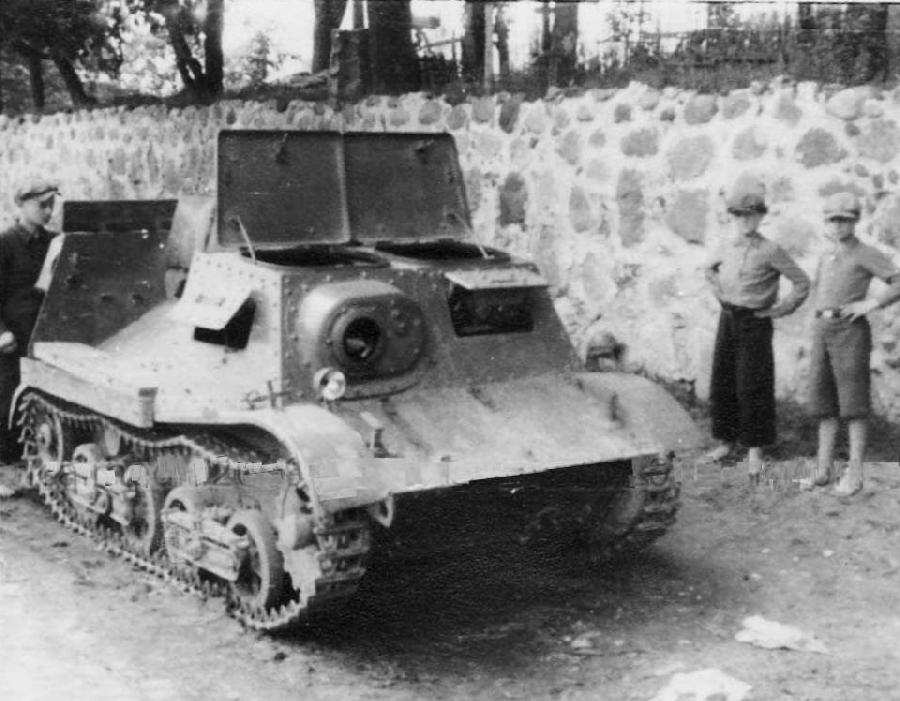
World War II Technology: Tank Design

Figure 1.--This is the Soviet T-27 Tankette. It was based on the British Carden-Loyd Mk VI. It was designed by N. Kosyrev. Production began and eventually exceeed 7,500 in three variants. At the time World War II broke out, many countries had small tanks like the T-27. The United States deployed the the M-3 Stuart which saw action in North Africa. This photograph was probably taken in the Ukraine by a German soldier in July 1941. Besides the small size (it was operated by small soldiers), note the straight pannels of armor. Slopeing armor was an inocation developed during the War. Also notice the small gun.
|
|
There are three basic elements to tank design: 1) armor (protection), 2) firepower, and 3) mobility/speed. Maximizing one element will impair the others. Increasing the armor means greater weight which can impair mobility/speed. Thus tank design requires compromises adjusting these three major elements. These were not, however, the only factors affecting World War II tanks. These ease of manufacture and cost as well as the field maintenance requirements have also affected the effectiveness of tank forces. Vost and complexity affected how many tanks coukd be built and thus the size of a country's tank force. As a result the afordability and industrial requiremrnts may take precdence over performance characteristics. The Germans in World War II fielded some excellent tanks, especially the Panther tanks. The German designs, however, tended to be complex to build and ill-suited for assembly-line mass production. They were also often demanding to mauntain and service in the field. Hitler who intervened in weapons production also had a penchant for gigantism--culminating in the massive Tiger tanks in the later phase of the War. The Soviets and the Americans on the other-hand developed tanks that could be quickly-built in large numbers--the T34 and the M4 Sherman. The M4 in particular had serious design weaknesses, but the numbers of both tanks overwealmed German defenses. Hitler in a secretly taped conservation with Mannerheim admitted that he never imagined the number of tanks the Soviets could produce. And that was before the Wehrmacht faced nassive American armor attacks. Logistics was another factor. The T-34 and M4 were both relatively simple to maintain. The more complex German designs were much more difficult and this was futher agrivated by the relatively poor German logistics system. Firepower is perhaps the key element as the whole purose of a tank is to rapidly move weapons forward. In World War I it was to support infantry. In World War II it was to spearhead offensive attacks. We see many small tanks early in the War (figure 1). The size of tanks grew steadily during the War, primarily to support larger guns. German tanks led in this area throughout the War. Some tanks had the fammed 88mm gun and by the end of the War even larger guns. The American M4 Sherman was notoriously under gunned, unable to penetrate German armor. The armor is the most destinctive feature of a tank. The German tanks also tended to be heavily armored. The quality and thickness of steel was not the only factors determining the effectiveness of armor. The Soviet T-34's use of slopeing armor enabled it to gain speed and mobility without massively heavy armor. The compromise between armor and speed lead to the T-34 often being cited as the best tank of the War. Speed is an important factor affecting mobility, but not the only one. Tanks to be effective have to move off roads and thus have to be able to traverse a variety of terraine. Here the T-34 and M4 were highly mobile. The German attack Bulfe Offensive at the end of the War was impaired by the Tiger tank's inability to cross many narrow, weak bridges in the heavily wooded Ardennes. Another factor here is the need to transport tanks to the battlefield. An factor in the design of the American M4 was the ability to tansport it to ports by rail. Passing through railroad tunnels was a factor.
HBC

Navigate the Boys' Historical Clothing Web Site:
[Return to Main World War II tank page]
[Return to Main World War II land technology/tactics weapons page]
[Return to Main World War II land technology/tactics page]
[Return to Main World War II technology/tactics page]
[Return to Main World War II page]
[Introduction]
[Activities]
[Biographies]
[Chronology]
[Clothing styles]
[Countries]
[Bibliographies]
[Contributions]
[FAQs]
[Glossaries]
[Images]
[Links]
[Registration]
[Tools]
[Boys' Clothing Home]
Created: 5:11 AM 1/27/2010
Last updated: 5:11 AM 1/27/2010



